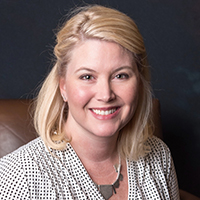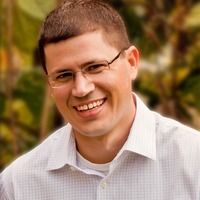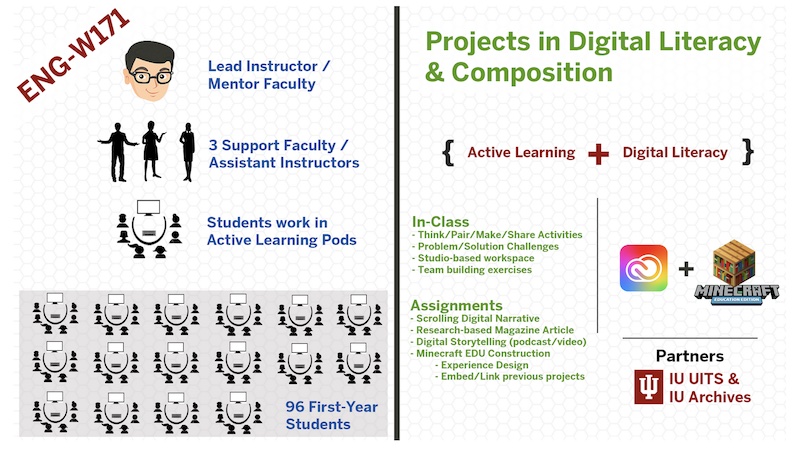Minecraft banner image created by Jordan Krinsky, Ryan Canfield, Evan Berger, Joey Bengs, and Chase Sotsky, students in Hodgson's pilot course exploring digital writing practices using the IU Bloomington campus as their grounding artifact.

Miranda Rodak
Clinical Associate Professor and Director of Undergraduate Teaching, Department of English, IU Bloomington
Rodak is also a Senior Faculty Fellow in the Mosaic Initiative at Indiana University.

Justin Hodgson
Associate Professor of Digital Rhetoric, Department of English, IU Bloomington
Hodgson is also co-lead of the Digital Gardener Initiative at Indiana University.
In fall 2022, Miranda Rodak and Justin Hodgson began piloting a new model of composition focused on high-impact practices like active learning and digital literacy. The course, Digital Literacy and Composition (W171), took a traditional composition curriculum focused on teaching foundational skills and re-envisioned it through project-based learning and hands-on uses of technology. It also added in a mentor/apprentice dynamic among the instruction team, featured challenge-based engagements (in research, in writing, in media creation), and involved key partnerships with both UITS Learning Technologies and the IU Archives.
Below is a conversation with Rodak and Hodgson, edited for length and clarity, about how the pilot took shape.
What was your initial inspiration?
Rodak: I've been thinking a lot over the years about how to engage more active learning methods. As a university, we have a great opportunity when students are required to come through composition. It's a gateway to introduce them to projects as a way to learn and to digital literacies that dovetail well with skill sets like critical reflection. And, as director of undergraduate teaching, I also want to support, train, and professionalize my graduate student instructors.
What did you hope to accomplish?
Hodgson: The goal of this course is to build better learning experiences. We want to do something meaningful and engaging. So we created opportunities for students to learn writing skills while creatively solving problems. And that was a benefit to the whole class.
The particular group of 96 students that I taught last fall was really incredible at collaboratively solving problems. I gave them a set of challenges and engagements to work on, got out of the way, and waited to see what they created and what they learned. It's a far more rewarding experience than when they just tell me what I expect them to know.
The practical values of integrating digital literacy into the curriculum
- Expand student capacities for expression
- Deliver and access course content/practices in new ways
- Find meaningful success outside traditional modes of academic discourse
- Provide a built-in orientation to sharing digital work
For more details, including examples, visit a recent presentation by Hodgson about innovative teaching and learning through Adobe.
To explore how these values shaped the pilot course, visit Projects in Digital Literacy and Composition.
What issues were you trying to address?
Rodak: First, the majority of our graduate students teach composition courses that are intensive in terms of writing, instruction, and grading. We want to streamline that labor, but not at the cost of the pedagogy and the learning outcomes for students in the course.
Second, because of the typical departmental structure, graduate students almost never get to see faculty teaching composition courses. We talk about teaching, but they don't really see it modeled for them in a writing classroom. And when we ask them to engage in writing pedagogy in a way that's active for students, they've almost never experienced that.
Hodgson: The mentoring model gives both graduate students and faculty a chance to explore active learning spaces and high-impact practices together. We're creating a more flexible learning environment in which everyone—faculty, graduate students, and undergraduate students—is comfortable taking risks. As a result, we're engaging in something a little more creative, a little more critical, a little more collaborative.
Rodak: It takes a lot of confidence to do a kind of active learning centered pedagogy where you start opening up and de-centering the classroom. It's easier and less anxiety producing to prepare your script in advance. To have real active engagement with your students, you become a kind of improv actor and you have to be able to go with whatever you're handed.
How did the fall 2022 pilot take shape?
Rodak: Backing up just a second, I also want to touch on the problem of scale. Universities are putting pressure on English departments to expand the number of students in composition courses. But in order to help students develop writing skills and rhetorical awareness, you need to keep classes to 23 first-year students.
I decided to approach the problem in a different way: If we can't scale the numbers the way our institutions would like us to do, is there another way to think about scale? What if we were scaling not the number of seats but the ratio of instructor to students? What if we could scale the expertise of the faculty member?
We embedded graduate student instructors within a co-teaching, collaborative model in a large active learning classroom (Student Building (SB) 015) with essentially four people in charge. The lead instructor/faculty mentor takes on more of the intellectual labor around course design and answering big questions. Meanwhile, the graduate students are not just graders, but rather co-teachers who help move around and guide students in that active learning space.
All 96 first-year students take a class with a faculty expert. Both lead and support instructors bounce ideas off of one another. Afterwards, the graduate student instructors teach their own 23-person spin-off courses that continue these active learning and digital literacy practices.

In my reading about communities of practice, I've noted how students benefit when they see themselves as sub-communities within larger communities. SB015 gives us the ability to bring four different classes together and share across what would normally be class sections, but is now broken down into groups of six collaborating on challenge-based engagements.

